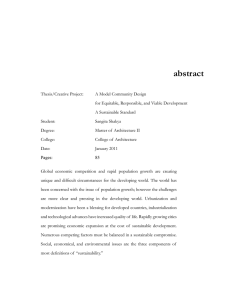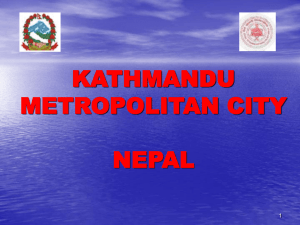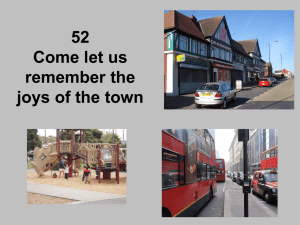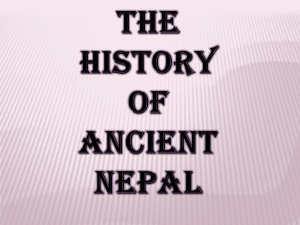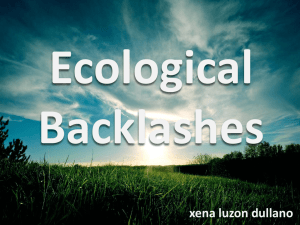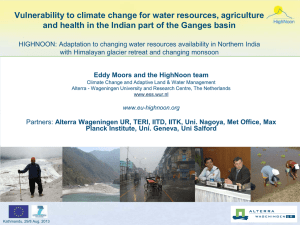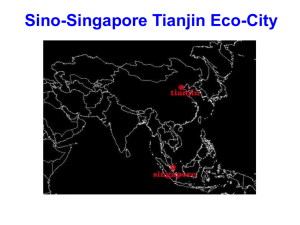Ecocity 2008: Sustainable cities
advertisement
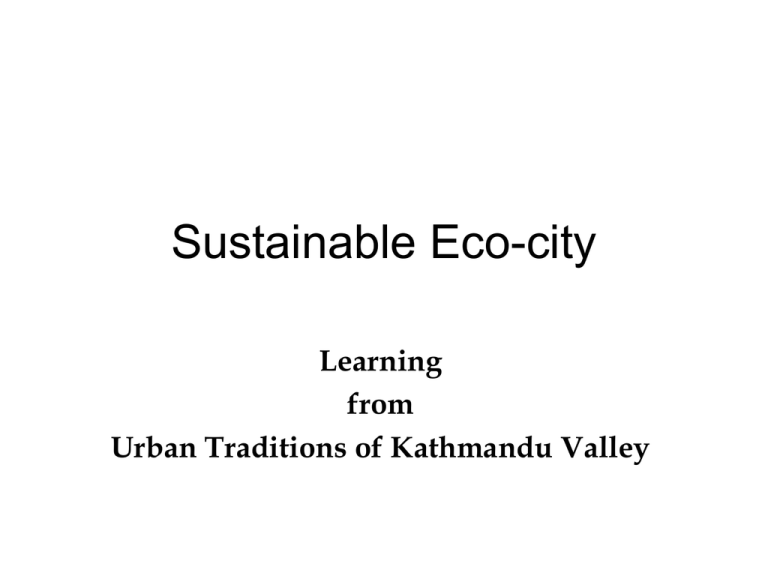
Sustainable Eco-city Learning from Urban Traditions of Kathmandu Valley Urban Sustainability • Town system consists of Society, Settlement and Nature – Has a innate tendency to cause distancing from each other with ‘development’ leading to unsustainabilty – Has a concentration of people and economic activities • With material and energy inputs and waste outputs also dense and concentrated • In an open continuum with the hinterland ( urban/rural) • Town needs to be seen – as a social entity – as a economic entity – as a ecological entity in the scheme of Nature Eco-sustainability of Urban System • Urban system is not closed, it can’t sustain by itself – Because of Its resource dependence on ‘hinterland’ (basically for food, water and energy), whose extent is ever increasing with time! – Its waste environment that pervades into water, air and land around (fire/thermal and ether/space also?!) • In addition to Resource and Waste environments, Urban ecosustainability has to consider – Socio-cultural environment (understanding and set up for sharing) • Current as well as Future generations • Unsustainable urban system DECAYS! • Urban ecological unsustainability happens when it decays or causes decay in one or all of its environments – Physical, Economic or Social > go to urban ecology schema Urban Culture: Urban Ecology NATURE: Physical Environmental Chains ECONOMY: Resources & Waste Chains SOCIETY: Social set up for Sharing/ Competition Urban Decay • Decay in urban systems occur due to – Failure of the supporting capacity (a sum total of resources and regenerative gains) – Failure of the assimilative/recycling capacity of Nature (a sum total of waste disposed) – Failure of distribution of wealth: urban poverty and social degeneration – Social order: fragmentation and loss of community behavior Lessons of History • Kathmandu Valley has a long history of sustained urban settlements • Kathmandu Valley is almost a closed ecosystem (micro-global character) • Towns of Kathmandu in History would have also faced threats of social, economic or physical unsustainability. – Review experimentations/technologies in successful approaches towards sustainability – Social agreement/ dialogues in urban culture – Nature and extent of individual/community behavior over the ‘period of sustenance’ – Social/cultural/human foresight Kathmandu: Natural Characteristics • Bowl shaped topography, valley 25 Km across and 1.5 Km deep on average. – Lake deposits, high fertility soil – Rain fed, all rivers originate within the valley – Single drain off outlet • Water and Land sub-systems at Microequilibrium > go to Valley outline map Legendary City: MANJUPATTAN Budanilkantha Manichur Jamacho Ichangu Narayan Svayambhu Kathmandu Legendary City: BISHAL NAGAR HANDIGAON Guhyeswori Changu Narayan PASHUPATINATH Sankhamul Patan Bhadgaon Chandagiri Shikhanarayan Bisankhu Narayan Phulchoki N Kathmandu: Urban Peculiarities • 2000 years old tradition of Dense settlements • Towns as old and continuously Lived-in – Always located on Higher Grounds within the Valley > go to Bhaktapur picture – With a pond at its Higher Level > go to Gahanapokhari picture – Public Water Supply System of Pit Conduits – Temples at Street Crossings > go to Nyatapola/Jaisidewal pictures Cross Roads Marker of Kirat days from Jaisideval/ Tegvala Kirat make a start at Urbanism! • The idea of a Settlement – Sitting on fallow ground in a fertile valley – Served by pit conduit water supply system fed by a reservoir pond at its highest level – Dense and contained within a defined boundary – With Cross-road spaces marked for Urban socialization • Was basically of the Kirats (before 78 CE) • And Not of the Lichchhavis (78 -879 CE) – Who came from Gangatic plains with the classic Vedic/Hindu/Buddhist ideals and know-how of planning – Riverbank flatland pattern of settlements – Well system Eco-urbanism of the Kirat • Dense and bounded settlements on high ground: Preservation of economic base/agricultural land • Integration of nature, economy and society – Dyochhe, pith and norms of social behavior > go to pics of d/p • Pith located at ecologically sensitive spot such as Water holes, Springs, Land humps, Clump of trees – Divine presence = ecological variance • Festivals – sharing resources and recognizing the urban/rural continuum – Imprint the rules in the minds of people – Carry the rules over time/ future generations – Socio-cultural nurturing of the hinterland > go to schema Pigan Festivals (Mar-Apr) display Social Agreements on Natural Ecology and Settlement Economy & Ritually Mediate the agreements over space and generations A pith: Numinous Stones, Family of Siva On to 2nd Cultural Period • Population increases – Resource base is expanded – Towns reach out to valley foothills for Water supply sources – Social/cultural mediation of new ecological realities, understandings and responsibilities – Town Festivals extend out to the resource locations. • Settlements get enlarged – Andipringga > Bishal Nagar – X8 to 1 sq. km. in extent – Lichchhavi image the town as a Vedic microcosm, geometrically as well as philosophically – Vaastushastra and Environment of the five elements > go to schema >go to Lichchhavi pattern >go to Daxinkoligram pattern Earth Water Fire Air Ether Everything consists of Pancha-tatwa, the five transformation modes/elemental principles. With the sense (bhuta) of Sound, Touch, Form, Taste and Smell, the fifteen characteristic quality-nature (guna) of elements are formed – that is universal (nitya). … There should be no tampering of the tatwa Environment – This has to be the universal ecological imperative. Lichchhavi Pattern • Daxinakoligram • Dandaka pattern • Ikhapokhari Jalasayanarayan? • Onde Narayan • Ikha Narayan • Chikanmugal N • Makhan N IKHA POKHARI IKHANARAYAN JALASAYINARAYAN CHIKAMUGAL NARAYAN JAISIDEVAL HYUMATNARAYAN ONDENARAYAN Eco-urbanism: 2nd Cultural Period • Guthi: a community based management – Surplus Private wealth as “Public Endowment” – Community ownership and operation of land – Community engagement in maintenance of services • Recognition of water supply as a urban service – – – – – Socio-cultural mediation of urban rural continuum Closing the ‘urban-hinterland distancing’ Playing out interdependencies Festivals extend out to sub-regions Become almost global by 10th century ( eg Matsendranath) >go to wastewater treatment Moderating Water Pollution • Lichchhavis start septage/waste water recycling • The reeds garden (Natapata vatika of the Lichchhavis) south-east outfall and treatment area Departures of the 2nd Period • Imaging the city: visioning • Surplus private wealth to public service • Community ownership and operation of land • Circular regenerative track:diffusing concentrative system • Regulating mechanism spanning current and future generations: Framing universal rules/ reaching agreements on values On to 3rd Cultural Period • Towns become still larger: Bhaktapur is laid out for 12000 houses at start of 13th century – Social heterogeneity of the town increases • Urban Ecological problem build up – Economic competitiveness for ‘plenty and surplus’ and disparities in sharing of gains, developing urban poverty – Over-exploitation of resources – Heavy waste generation/little assimilation/ land and water pollution and towns spilling boundaries – Further distancing of man from Nature. – Towns are drier and warmer Eco-city: 3rd Cultural period • Development through a Mix of – Kirat ecological prototype > to schema – Lichchhavi’s urban planning principles • Eco-sensitive ritual bounding and structure – Bounded urban development, Dune and Pine >to schema – Ritual/Social mediation of Wider urban-rural continuum (resource base) – Tole sectorization, homogeneous neighborhood >to schema Eco-city: 3rd Cultural period • Responding to 'micro-heat, dry regime & waste sub-structure’ – Capitalizes positive aspects of 'new nature‘ – Potentially mitigates negative results • Micro-heat: – – – – – – High Density/Low rise dev.: warmer micro-climate tight layout with small courtyards > Itum Bahal predominance of paved streets/ heat gain > Itum Bahal "No-Greenery-inside” – Was this a wrong move? Lachhi – setback for a sunny spot in narrow lanes Lung space: peripheral Khyos Eco-city: 3rd Cultural period • Responding to 'dry regime’ – Use of water-accepting technologies – Pervious paving, open joints – Surface collector drains separated from deep drains – irrigating the dula or recharging kuwa – Use of wells inside tole and pit conduits between neighborhoods > recharge through own waste water > protecting from pollution >go to well Eco-city: 3rd Cultural period • Responding to 'waste sub-structure’ – Communal toilet streets, night soil collection and raw sewage manure agri-practice- ‘output-input’ > Schema – Waste management:garbage and Sagah • Capitalization of micro-heat: composting • Health hazard management: periodic cleaning through seasonal rituals: Lukumadyo/Pasachahre (Chait) >go to pic – Sithi: Cleaning and maintaining water supply systems in the driest season (Baisakh/Jeth) • Water for seeding – Sithi: Maintaining other ‘urban services’ – public buildings • Lean agricultural season v]tsf] k]6df k]6sf] v]tdf FARM FOOD MANURE WASTE Recycling Through Use of Extra Urban Heat * Compost and Sagah Eco-region: 2nd 3rd Cultural period • Eco-region goes ‘global’ or valley-wide • Further away, agricultural land and forested hillocks protected and preserved. • Watershed areas and sources of rivers given religious image as a preservation primer • Ecological responses cover PES environment and actors MSN in totality Lessons of History • Setting up the new motives and evolving ethical behavior: ritually mediated plan • Cities planned and patterned after a perceived image of cosmos/ use mediated by rituals • Accommodating growth but remaining complete and balanced at all times as a mental construct • Plan in the mind of the user • Exploiting human ethics, individual faithfulness and emotionally guided inner discipline Lessons of History • The Target of Future Generation • In contemporary society with notoriously shortsighted present/ development paradigm centered on the present man • ‘Future generation’ is not a fixed ‘time span’. • Plans of indefinite time frame/process objectivity: karma, dharma and philosophy of rebirth: rolling present and future into infinite time/one entity. • Buddhism and material frugality, 'virtuous behavior and observance of social order' as a life-principle in Confucianism Lessons of History • Bounded but Interacting Urban and Rural systems • Kathmandu Towns conceived as bounded entities with set of perimeter gods and goddesses defining physical boundary: taboo to build outside • Towns of Kathmandu on less irrigated tar: Utility of bounding mundane: save the economic base. • Distinct and protected hinterland for ecological sustainability Lessons of History • Managing Dependencies • Urban-rural linkage/ two inter-dependent systems managing dependencies – Containing overexploitation of resources, exclusive exploitation and consequent deprivation of the rural area and lack of commensurate return of the benefits or other inputs back to the hinterland. – Interacting activities seeking participation of both the dwellers of the city and the hinterland in preserving and maintaining the resource • Festivals: ritual play or exercises in regionalism, preservation and citizen participation Lessons of History • Land Donated in Perpetuity/ Community ownership • Effective tool of building sustainability through community participation • Creation, maintenance and operation of elements and processes of providing public good/ decentralized participatory management • Appeal to philanthropic instincts to canalize individual wealth into community good. • Most precious and permanent of properties/ healthy association of land and community Lessons of History • Social cohesion in Multicultural society and the town • Saving sustainability in societal heterogeneity • Efforts at making pockets of homogeneity. • Sustainability of cultural diversity within multicultural societies: Mosaic scenario & not religious neighborhoods • Well within tole & Conduit between toles! Graded community behavior? • Other defined acts/ Karma and process objectivity
